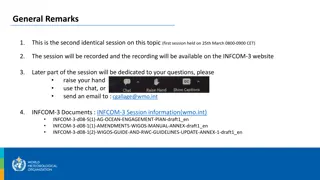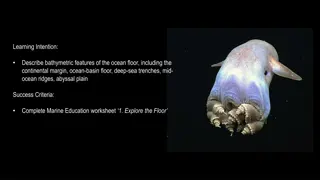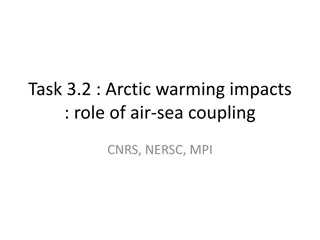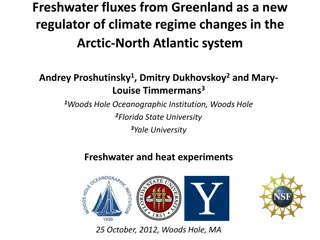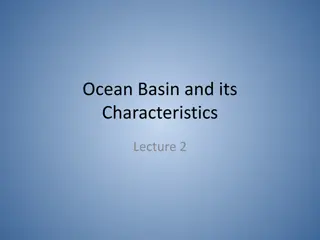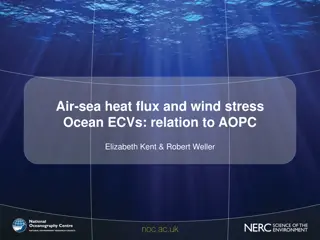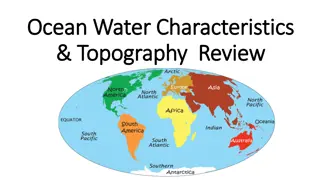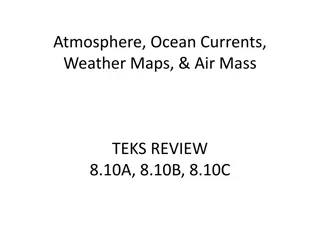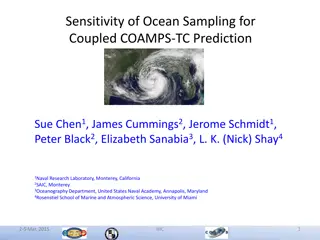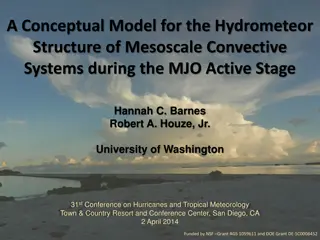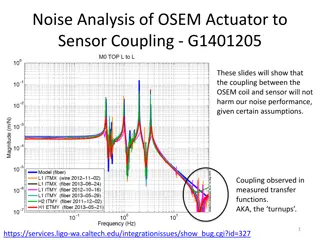Understanding Atmosphere-Ocean Coupling in Madden-Julian Oscillation
Atmosphere-ocean coupled processes in the Madden-Julian Oscillation (MJO) play a crucial role in intraseasonal oscillations. This paper review by Shao Yun-Chuan explores how the ocean's Sea Surface Temperature (SST) influences surface fluxes, MJO convection, and energy balance dynamics. It delves into the factors controlling intraseasonal surface flux variations, relative phasing of SST, surface fluxes, and rainfall, highlighting the complex interactions between the atmosphere and the ocean in driving MJO phenomena.
- Madden-Julian Oscillation
- Atmosphere-Ocean Coupling
- Intraseasonal Oscillation
- Energy Balance Dynamics
- MJO Convection
Download Presentation

Please find below an Image/Link to download the presentation.
The content on the website is provided AS IS for your information and personal use only. It may not be sold, licensed, or shared on other websites without obtaining consent from the author. Download presentation by click this link. If you encounter any issues during the download, it is possible that the publisher has removed the file from their server.
E N D
Presentation Transcript
Paper Review Atmosphere-ocean coupled processes in the Madden-Julian oscillation (PART I) speaker Shao Yun-Chuan
Citation DeMott, C. A.1, N. P. Klingaman2, and S. J. Woolnough2(2015), Atmosphere-ocean coupled processes in the Madden-Julian oscillation, Rev. Geophys. 53, 1099-1154 1 Department of Atmospheric Science, Colorado State University, Fort Collins, Colorado, USA, 2 National Centre for Atmospheric Science-Climate and Department of Meteorology, University of Reading, Reading, UK
outline Introduction MJO Forcing to the Ocean Ocean Response to MJO Forcing Ocean Feedbacks to the MJO Modeling
Introduction Discovered by: Roland Madden and Poul Julian in 1970s Scale: O(10,000km) Period: 30-70 days, intraseasonal oscillation(ISO) Velocity: 5 m/sec, eastward To figure out: 1. How does the ocean SST modulate surface fluxes throughout the MJO life cycle? 2. How do SST-modulated fluxes impact MJO convection?
MJO Forcing to the Ocean The surface energy balance Factors controlling intraseasonal surface flux variations Relative phasing of SST, surface fluxes and rainfall
MJO Forcing to the Ocean The Surface Energy Balance
MJO Forcing to the Ocean The Surface Energy Balance 1. The mean latent heat are weaker in Indian Ocean, means the shortwave radiation has a stronger influence . 2. Intraseasonal air-sea interactions are primarily driven bythe atmosphere. 3. Central role for clouds and convection in modulating the surface exchanges of radiant and turbulent energy. 4. Ocean warming by solar radiation is strongly modulated by cloud properties. 5. Intraseasonal variations in wind-dominated surface turbulent fluxes are driven by downdrafts and large- scale wind anomalies.
MJO Forcing to the Ocean Factors controlling intraseasonal surface flux variations 1. q is the near-surface vertical moisture gradient (qSST- qair,qSST is the saturation specific humidity) 2. T is the temperature gradient(TSST Tair) 3. |V| is wind velocity 4. Overbars represent the background means, primed quantities are time- varying departures from the background means. 1. Zonal wind anomalies of either side may produce suppressed or enhanced fluxes, depending on the sign of the mean wind 2. q and T are more sensitive to qairand Tairthan SST, particularly near convective downdrafts. 3. A given |V| and Tair(qair) will produce a stronger sensible(latent) heat flux over a warmer patch of ocean than it will over a colder patch.
MJO Forcing to the Ocean Relative phasing of SST, surface fluxes and rainfall MJO suppressed phase : 1. Decreasing cloudiness, wind and surface fluxes 2. Increasing surface radiation MJO active phase initiation: 1. Increasing cloudiness, and reduced surface shortwave radiation followed by an increase in wind speed and surface fluxes out of the ocean and decreasing SSTs.
Ocean Response to MJO Forcing Processes affecting the upper ocean Intraseasonal mixed layer heat and salinity budgets The mixed layer diurnal cycle
Ocean Response to MJO Forcing Processes affecting the upper ocean
Ocean Response to MJO Forcing Intraseasonal mixed layer heat and salinity budgets In Equator: Advection dominates the ocean process In 10E: Vertical mixing dominates ocean process Positive : contribution of surface fluxes to mixed layer temperature budget. Negitive : contribution of ocean dynamics to mixed layer temperature budget
Ocean Response to MJO Forcing The mixed layer diurnal cycle The presence of diurnal warm layers and shallow mixed layers provides a near-surface energy reservoir .
Ocean Feedback to the MJO Sensitivity to interannual SST variability Sensitivity to intraseasonal SST variability Sensitivity to diurnal SST variability
Modeling The past numerical experiment showed an enhanced MJO in the GCMs by 1. Introducing momentum mixing by convection to reduce vertical wind shear. 2. Revising the triggering of convection to account for low-level horizontal moisture convergence. 3. Altering the convective parameterization to enhance shallow-convective heating and moistening east of the MJO active phase, or to produce more upper level heating from stratiform precipitation. 4. Artificially increasing the westward tilt of the GCM diabatic heating profile with height. 5. Increasing the sensitivity of an ascending convective parcel to environmental humidity. 6. The transition from shallow to deep convection appears to be particularly critical.
Modeling Upper Ocean Response to Atmospheric Forcing Slab Ocean Model The Coupled Model Mean State High-Frequency SST Forcing Air-Sea interaction and MJO Prediction





